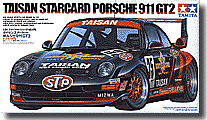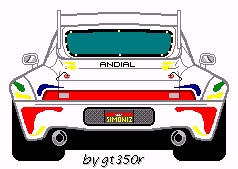Take one Tamiya Taisan Starcard Porsche 911 GT2 (kit #24175). One Scale Designs Porsche 911-GT Evo-Daytona/Sebring 1995/96 #74 Champion STP decal sheet (SD15). Add a smattering of scratchbuilding skills and reference material and in no time you have an American roadrace champion.

The Taisan Starcard 911 competed in the 1995 Japanese GT Car Championship, winning one race. The 911 Porsche GT2 was built to compete at Le Mans in the GT2 class, but it was also eligible for IMSA's Exxon Supreme GTS1 category. Champion Porsche of Florida entered this car in the IMSA endurance race series with Hans Stuck and Bill Adam. The car utilized a very unique paint design. The basecoat was white, with multicolored reflective "jelly beans" covering the body. Interesting additions were the neon car number indicators in the rear quarter windows used to identify the car during nighttime racing.
While the decal sheet is extensive, a few are missing. Namely the 2 jellybeans on the drivers side mirror and one from the passenger mirror. The Andial decal is missing(F). Its positioning is in place of the 911 GT, #65 decal on the SD sheet, on the center of the back lower engine cover. There is a Los Angleles Raiders decal in the lower front corner of the drivers side quarter window that is missing as well. All the interior decals are missing so why not buy 2 decal sheets? The Racer article will give you the placements. Also, don't install both quarter window neon 74's as only one was used during the race. Which side it was installed on depended on the pit location. The interior is white as are the BBS wheel centers, with the wheel retaining nuts red. The tires need white Goodyear and Eagle markings and none are provided in either the kit or the SD decal sheet.
On to the body. As usual Tamiya has gotten it all right. Inside the box you'll find a perfectly detailed GT2. The only problem I found was with the fit of the upper and lower halves of the engine cover. Because of the design of the piece, the air intakes are put together clamshell-style. This makes filling and smoothing the seams a little more difficult. The kit's quality and building quirks have been reviewed in various periodicals, so I won't go into them further.
I used various reference sources to determine the differences between the two cars including Racer magazine's In Focus article, August 1995; Motor Racing Models #32; A few online sources; and various video tapes from my collection. There is also a photo set by Tim Crete. They are available from Model Car Masterpieces or Grand Prix Models exclusively. I have yet to check them out, but MRM used them and they look great.

Lets start with the first problem. The color of the Tamiya model: BLACK. Tough to change into white, but not impossible. Tamiya has recently released the Sogo Keibi 911 GT2. It IS white, but it has a diffferent front end and I'm not sure the the Taisan one will fit. So we'll play the hand we've been dealt. Use your favorite technique to convert the color over. There are subtle body differences between the two cars. The #74 has a small, vertical, natural aluminum chin spoiler with 5 retaining screws attached to the front underneath of part #A 10. Also, 2 flat white panels(A) are riveted onto the body to cover the gap between the lower body and part A 10.

One on each side. They are centered and extend from the middle of the molded lip on the lower air intake to the point where the side marker light begins its outer, upward curve. The lower front air intakes need to be backed by black painted screen. Also black screen should be installed behind the intakes located directly next to the sidemarker lights. The #74 has a full-length hinge for the fuel door. I know, a SMALL detail but a detail nonetheless.
Moving up the "hood". A quick disconnect (B) air coupler for the onboard airjacks must be "scratched" and installed on the lower windsheild cowl. Its location is about 2" to the inside of the emergency cutoff switch. You can install it on either side, your choice. And a cover must also be built and installed on the unused side, as the coupler is interchangable depending upon pit configurations. The front windshield needs 6 safety clips (C), a la NASCAR. 3 on the bottom, 3 on the top.

The driver's side glass needs to be cut out, leaving the vent window intact, with a safety net installed in its place. The passenger side rear window needs a round hole cut into it about 4" behind the neon 74. The rear windsheild uses 12 Dzus fasteners to attatch the Lexan piece to the body, 3 on each side. The rear engine cover needs 2 hood pins (D) installed 2" up and 4" in from the lower edge of each side. The rear undertray (E) is flat across its lower edge. The kit's edge has 2 eyebrows for the exhaust which need to be modified. The kit-supplied exhaust pipes appear to be correct, but painted semi-gloss black.
The rear tow loop extends out of the rear bodywork in a different location than the kit's. The loop comes out the passenger side is mounted in a vertical axis and should ALMOST completely pierce the Goodyear decal when properly applied. Also, the car has the license plate holder cut-out and black screen installed in it's place. Another aluminum blockoff plate (G) must be built and installed on the upper rear passenger fender about 3" under the window and 3" back from the rear door edge. I'm guessing this is an alternate location for a quick disconnect air coupler for the onboard airjacks. Enough for ya?

On to the interior, which is...you guessed it, white! I've been told that the rollcage is incorrect for IMSA and needs a few more bars in the drivers door section, but can't confirm it at this time, so I'll leave it out. First off is the "carpet". Yes, there is some. It looks to actually be an industrial anti-vibration pad. It extends from the driver's footwell to the black Recaro seat. The pad is black, with large washered screws to attatch it to the floorwell. The "wings" of the seat are grey, and it needs a white Recaro decal on the headrest.
The seatbelt is a Sabelt version in the Racer article but other sources have a Simpson unit. Either will probably do. There is an extra rollbar tube that runs under the entire length of the dash. It is covered with a grey pad and runs directly under the gauge cluster, to protect the drivers knees in event of a shunt. The steering wheel is a black leather covered Sparco unit, "D" shaped, with a red radio button on the left hand spoke. A coiled black radio wire is attatched to the wheel. The floor-mounted fire bottles have a black radio unit centered and mounted on top of them. It's attatched with a silver hold down bracket. I have not located a good photo of the wire loom used for the radio, so you're on your own!
There is a data aquisition box mounted on the back of the center crossbar of the rollcage on the passenger side. It is black, approximately 7"x7", with various connectors and a right side antenna sprouting from the top. Some of the wires run to the roof-mounted antenna. But again, the needed photos are rare and almost detail-less. 2 electrical wires enter the rear interior floor thru 2 large black grommets, running to the passenger side quarter panel. They are then "captured" under the aluminum fuel line. Where they go from there is only a guess on my part, but I'd say to the data aquisition box. The fuel line enters the compartment thru another large black grommet. It is mounted about 2 " above the floor in the passenger's rear floorpan compartment and proceedes to bend directly to the floor and then snake along the inner passenger frame rail. Exiting the interior !somewhere! under the dash.
Well, that about covers it. I hope you find this article helpful in building your own IMSA legend. Soon Tamiya will be releasing the Porsche GT1! Maybe I'll do the bare carbon fibre car from Le Mans '96 qualifying? Or, the FIA GT cars are coming to America later in the 1997 season to race in PSCR's GT class. Maybe we'll get a decal sheet for one of those as well! Are you listening Mike Q?

Porsche, the Porsche Crest and the distinctive
designs of the Porsche models are trademarks and trade dress
of Porsche AG.
References to Porsche and its automobiles are
included here for editorial, non-commercial purposes only.